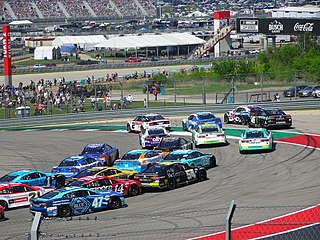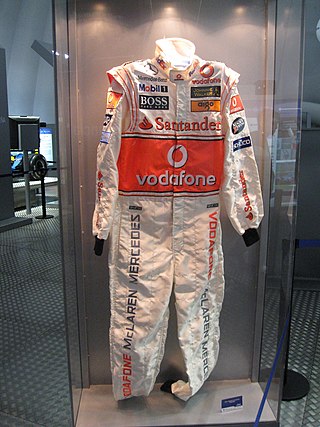Related Research Articles

Auto racing is a motorsport involving the racing of automobiles for competition. In North America, the term is commonly used to describe all forms of automobile sport including non-racing disciplines.

The Fédération Internationale de l'Automobile is an association established on 20 June 1904 to represent the interests of motoring organisations and motor car users. It is the governing body for many auto racing events, including Formula One. The FIA also promotes road safety around the world.

Mopar is the parts, service, and customer care division of the former Chrysler Corporation, now owned by Netherlands-based automobile manufacturer Stellantis. It serves as a primary OEM accessory seller for Stellantis brands under the Mopar brand. The name is a portmanteau of the words "MOtor" and "PARts". "Mopar" is also used as a nickname by enthusiasts of Chrysler-built products to refer to any product built by the company.

Car tuning is the modification of a car to optimise it for a different set of performance requirements from those it was originally designed to meet. Most commonly this is higher engine performance and dynamic handling characteristics but cars may also be altered to provide better fuel economy, or smoother response. The goal when tuning is the improvement of a vehicle's overall performance in response to the user's needs. Often, tuning is done at the expense of emissions performance, component reliability and occupant comfort.
A HANS device is a type of head restraint and a safety device in motorsports. Head restraints are mandatory when competing with most major motorsports sanctioning bodies. They reduce the likelihood of head or neck injuries, including the often fatal basilar skull fracture, in the event of a crash. There are many such devices on the market today, but the HANS is the original and the most common.

A spoiler is an automotive aerodynamic device whose intended design function is to 'spoil' unfavorable air movement across the body of a vehicle in motion, usually manifested as lift, turbulence, or drag. Spoilers on the front of a vehicle are often called air dams. Spoilers are often fitted to race and high-performance sports cars, although they have become common on passenger vehicles as well. Spoilers are added to cars primarily for styling purposes and either have little aerodynamic benefit or even worsen the aerodynamics.

A Hutchens device is used for protecting race car drivers in the event of an accident by controlling head movement, reducing head and neck injuries due to whiplash. It consists of a series of straps, attached to the helmet and connected across the chest and at the waist, depending on the lap belt for anchoring. The device was developed beginning in 2000.

The ARCA Menards Series is an American stock car series, the premier division of the Automobile Racing Club of America (ARCA). It is considered a minor, semi-professional league of stock car racing, used as a feeder series into the three national touring series of NASCAR, and hosts events at a variety of track types including superspeedways, road courses, and dirt tracks. It also provides hobby drivers a chance to experience racing at large tracks used in the three national touring series in NASCAR. The series has had a longstanding relationship with NASCAR, including using former NASCAR Cup Series cars, hosting events in the same race weekend such as Daytona Speedweeks, and naming an award after NASCAR founder Bill France, Sr. However, the series was not officially affiliated with NASCAR until its buyout on April 27, 2018.

The ARCA Menards Series West, formerly the NASCAR K&N Pro Series West, NASCAR AutoZone West Series, NASCAR Winston West Series and NASCAR Camping World West Series, is a regional stock car racing series owned and operated by the Automobile Racing Club of America (ARCA) and the National Association for Stock Car Auto Racing (NASCAR). The series was first formed in 1954 as a proving ground for drivers from the western United States who could not travel to race in the more traditional stock car racing regions like North Carolina and the rest of the southern United States.

Elwood Jesse "Bill" Simpson was an American racing driver, best known as a pioneer in the racing safety business with his company Simpson Performance Products. Later during his business career he branched into developing equipment for football safety.
The National Association for Stock Car Auto Racing (NASCAR) makes and enforces numerous rules and regulations that transcend all racing series.

The 24 Hours of Lemons, sometimes styled as "24 Hours of LeMons", "24 Hours of LeMONS", or "24 Hours of LEMONS", is a series of endurance races held on paved road race courses across the United States. The series holds the Guinness World Record for the "Most participants in one race".
Simpson Performance Products is an American motorsports parts supplier that manufactures safety products such as gloves, helmets, harness systems, driver's suits, head restraints, and shoes. It is marketed to racers ranging from participants at local track days to international Formula One and NASCAR teams. It was started by Bill Simpson as Simpson Drag Chutes.
Competition Cams, Inc., often styled as COMP Cams, is a specialty performance automotive aftermarket, motorcycle, and kart parts manufacturer. The company has five US locations including headquarters in Olive Branch, Mississippi.
The following is a glossary of terminology used in motorsport, along with explanations of their meanings.

The Spark-Renault SRT_01E, also known as the SRT01-e or the Spark Gen1, was an electric formula race car designed for the inaugural season of Formula E, in 2014–15. The car was the result of a 10-month collaboration between Spark Racing Technology, McLaren Electronic Systems, Williams Advanced Engineering, Dallara and Renault. The car was used until the end of Formula E's fourth season in 2018, after which it was replaced by the SRT05e.

FIA Formula 4, also called FIA F4, is an open-wheel racing car category intended for junior drivers. There is no global championship, but rather individual nations or regions can host their own championships in compliance with a universal set of rules and specifications.

The 2015 Coca-Cola 600, the 56th running of the event, was a NASCAR Sprint Cup Series race held on May 24, 2015 at Charlotte Motor Speedway in Concord, North Carolina. Contested over 400 laps on the 1.5 mile (2.42 km) asphalt speedway, it was the 12th race of the 2015 NASCAR Sprint Cup season. Carl Edwards won the race, his first of the season and first with Joe Gibbs Racing. Greg Biffle finished second. Dale Earnhardt Jr. finished third. Matt Kenseth and Martin Truex Jr. rounded out the top five.

A racing suit or racing overalls, often referred to as a fire suit due to its fire retardant properties, is clothing such as overalls worn in various forms of auto racing by racing drivers, crew members who work on the vehicles during races, track safety workers or marshals, and in some series commentators at the event.

Racing shoes, motorsport shoes or driving shoes are the footwear used for the practice of motorsport or day-to-day driving. They are generally built to provide comfort and precision for operating pedals for an extended period of time, with a narrow, close-fitting construction and thin, flexible soles, as well as to provide protection from fire along with a racing suit, in the context of motorsport. The standards for shoes worn in auto racing, as with other equipment, are regulated by FIA.
References
- ↑ "Blog Post An Introduction to Fuel Cells and Certification" . Retrieved 2022-08-24.
- ↑ "2022 SFI - Specifications for FIA Drag Racing" (PDF).
- ↑ "Our History | SFI Foundation" . Retrieved 2022-08-24.
- ↑ "SFI Spec 3.2A Driver Suits" (PDF). SFI Foundation. Retrieved 19 June 2023.
- ↑ "Clothing". Formula One. January 13, 2015. Retrieved November 8, 2016.
- ↑ "Impact Suit Technology" (PDF). Impact! Racing. Retrieved November 9, 2016.
- ↑ Wolf, Andrew (March 28, 2016). "In Case Of Fire: Is Your Safety Gear Up To Snuff?". DragZine. Retrieved November 9, 2016.
- ↑ "Archived copy" (PDF). Archived from the original (PDF) on July 11, 2011. Retrieved June 24, 2009.
{{cite web}}: CS1 maint: archived copy as title (link) - ↑ "Members". SFI Foundation, Inc. Retrieved November 8, 2016.
- ↑ "Kart Suits vs Race Suits" (PDF). Scrutineers News (5): 5. October 2014. Retrieved February 1, 2017.
- ↑ "2014 CAMS Manual of Motor Sport: General Requirements for Cars and Drivers; Schedule D - Apparel" (PDF). Confederation of Australian Motor Sport. January 1, 2014. Archived from the original (PDF) on March 27, 2014. Retrieved February 1, 2017.
- ↑ Spencer, Lee (June 5, 2015). "A safer approach to pit road". Motorsport.com. Motorsport.com, Inc. Retrieved June 5, 2015.